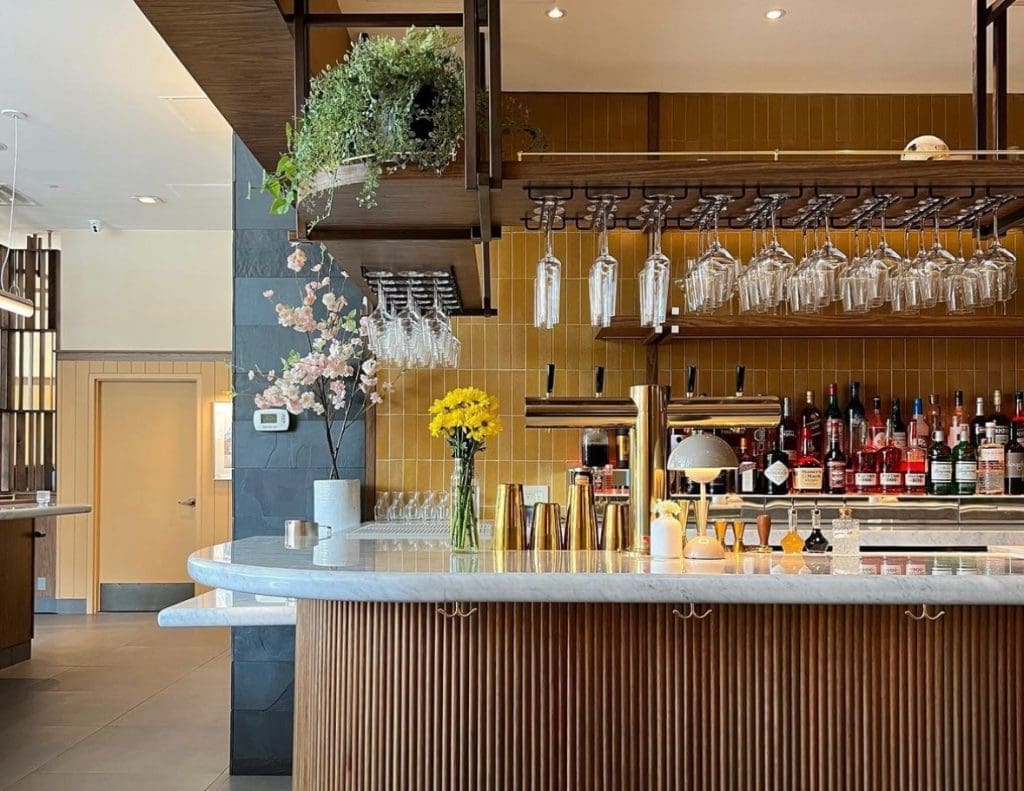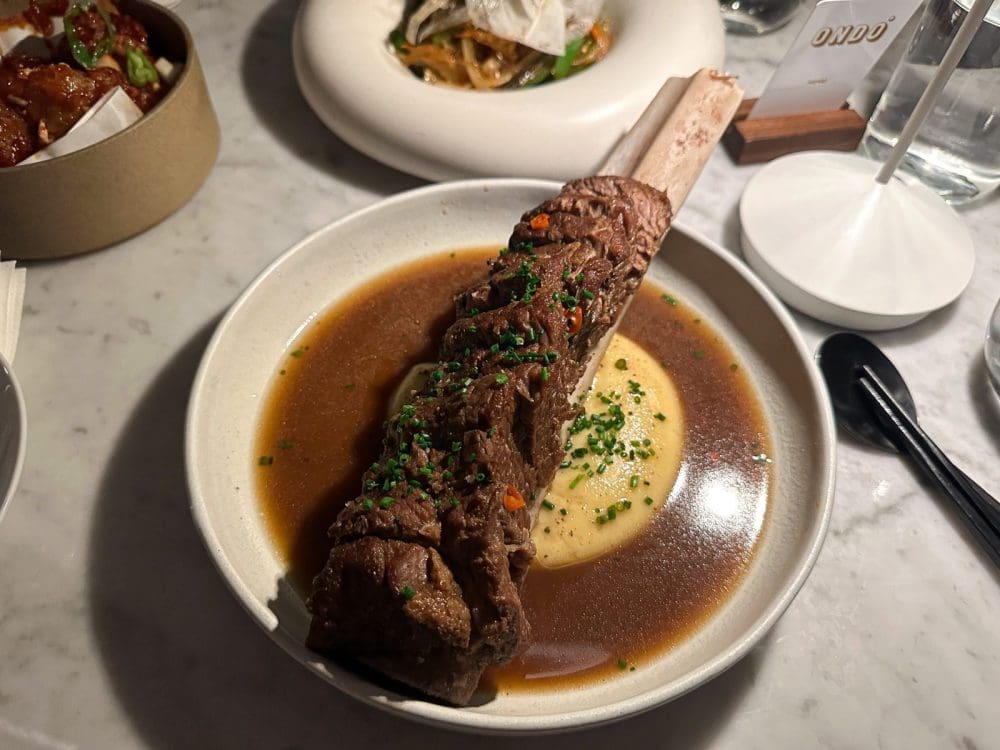There has been a lot of buzz surrounding Chef Brian Kim’s contemporary Korean restaurant, Ondo (온도), in Jersey City. From the artistically plated courses finished tableside to the inventive drinks and stunning design, Ondo puts on a Michelin-level show from all corners. I don’t get to Jersey City often, so when I do make the trek, I pray the experience will meet the trip. With the service kinks from Ondo’s opening being smoothed out, Chef Kim and the entire team met my particularities with ease.
Ondo, which is comfortably nestled right on the Hudson River, is the full performance. It is tough to find restaurants that leave you with the same feeling that a Broadway show does after the curtains close. The hours after the final bow— or in this case, the last bites of dessert— you replay the events over and over in your mind. A week and some change later, I am still replaying the Ondo experience in my head. That’s when you know a restaurant is special.

That’s because Chef Kim effortlessly combines classic Korean flavors and ingredients with the modernity required to make it as a restaurant at this level. With ease, traditional Korean fare is elevated and refined— while respecting the history and complexity that goes into the typical cuisine.
As you walk through the revolving doors at Ondo, you get the sense that you’re across the river dining at one of Manhattan’s finest restaurants. Or, perhaps we’ve made it 7,000 miles to one of Seoul’s own. Truth be told, Chef Kim, could’ve gone anywhere with success, but he came here. Ondo proves that geography doesn’t matter to define a restaurant. This stylish Korean spot adds to NJ’s roster of exceptional dining. Proving yet again that we are much more than New York’s younger sibling.

I showed up early for my reservation, so I took to the bar to wait it out. Ondo’s bartenders offer wine, cocktails, sangria, Korean spirits and beer. I was flustered by the options, but eventually settled on a Sherry Cobbler. The chug-worthy drink is classically composed of amontillado sherry, orange and sugar before being strained over pebble ice. At Ondo, sherry is split with Korean soju— a distillate made from rice— and blackberries are added to the mix. What you are left with is a complex beverage that plays off the natural nuttiness of amontillado sherry, but rounds itself out with soju, citrus and berries. The red-tinted drink, which comes on ice, is donned with mint and a spritz of absinthe before being placed in front of the guest. It’s aromatic and tart, yet incredibly balanced. Ondo takes a classic cocktail that many people have never heard of and takes it into the 21st century.

By the time the drinks were ready, so was our table. Ondo offers a-la-carte options as well as a three-course prix fixe for $85. I went with a-la-carte, which offers a unique way to dine. Their savory menu is divided into three distinct sections: Cold (35 F to 65 F), warm (70 F to 80 F) and hot (85 F to 145 F). This makes sense when you discover that the word “ondo” literally translates to temperature in Korean.
For my first course, I picked a cold and warm dish to exult in. First up, a straightforward yet powerful yellowtail crudo. The fish was sliced sashimi style and served raw as the name might suggest— with each piece fanning out into the shape of a semicircle. Atop the fish is thinly shaved fennel, pieces of red-veined sorrel and an edible purple orchid. Before I could dig my chopsticks into the dish, a server poured a vibrantly red sauce onto the plate.

I am a huge fan of yellowtail—also known as hamachi—and I find its fresh, mild flavor pairs really well with spice, but also with sweetness. Oftentimes, you see it coupled with jalapeño, which I absolutely adore. I came to discover the sauce was a gochujang and yuzu vinaigrette of sorts. The rich, fermented pepper flavor of the gochujang juxtaposed with the crispness of yuzu played perfectly together. Those are two heavy flavors, so I was worried it might overpower the fish, but it did the opposite. Instead, it complimented the delicate nature of the hamachi to a tee. Might I add the texture of the sashimi was otherworldly. I suspect a light cure was in play here, but I can’t be certain. The point is, this was a crudo that exemplified the concept of Chef Kim’s cooking— Korean flavors, modernized.
Now, the other starter I had the privilege of enjoying was none other than a spicy Korean fried chicken (sometimes known as KFC). If you know anything about Korean cuisine, you know that they may make some of the tastiest fried chicken in the world. I could write a novel on the different styles of KFC and what I distinctly love about each one, but time is of the essence. This particular chicken was a battered and boneless thigh. The meat seemed to have a double coating and fry, as the outer shell shattered like glass when biting. Inside, the meat was juicy and flavorful. The chicken was tossed in a gochujang sauce and topped with cashews, shishitos and small cubes of daikon. What more can I say? It was sweet and spicy chicken fried to transcendence. The batter was remarkable, and the chicken wasn’t overcooked. All things considered, it was a perfect bite of food. And yeah, I did double up on gochujang in my starters— when in Rome.

For the entrees, I chose a large format dish under the hot section of the menu and a smaller plate under the warm. Let’s start with the warm. Japchae, but in classic Ondo style— elevated, of course. Japchae is a traditional Korean noodle dish of stir fried glass noodles and vegetables. Glass noodles are a transparent noodle made from water and pure starch (usually sweet potato or mung bean starch). The starch doesn’t necessarily flavor the noodle, but creates a clear appearance and elastic texture. The use of non-flour starches makes glass noodles gluten-free as well.
At Ondo, the japchae consisted of glass noodles, fennel, jalapeño and shimeji mushroom— sometimes referred to as beech mushrooms. The stir fry was sweet and savory with a tinge of spice on the back of the palate. The textures were all over the place, but in a good way. The buoyancy of the glass noodles was met with the bite of fresh vegetables. Fixings like the fennel were added raw at the end for a fresh, anise flavor, while the others were stir fried with the noodles allowing them to ever-so-slightly cook. What you are left with is a comforting bowl of noodles. Plain and simple.

Next to the noodles was what I consider to be the star of the evening: The Galbi-jjim for two. Galbi-jjim is a Korean dish consisting of braised short ribs, often served as a stew. Galbi means short rib and jjim means to braise or cook in broth. Traditionally speaking, the dish is flavored with soy sauce, Chinese dates, pine nuts, chestnuts and more. At Ondo, a large, bone-in beef short rib is braised, but rather than being served as a stew, it is served in the style of a roast. The beef is removed from the bone and sliced before being placed back on top of the bone as a serving vessel. In the plate underneath, the sweet and umami-rich cooking liquid pools around a pile of chestnut puree at the heart. Thin sliced chilis and chives finish it off.

The meat is incredibly well-flavored. Rich, beefy flavor is harmonized by the tune of the sweet and earthy flavors in the cooking broth. The jus tasted subtly of soy sauce, but without being overly salty. The chestnut puree was a fun touch, as the traditional dish is finished with chestnuts directly in the stew. The dish is served solely with a spoon and chopsticks. No knife. Chef Kim definitely has some confidence. As he should, because the short ribs are melt-in-your-mouth tender. One of those bites of food that is immediately met with your eyes rolling back and a sigh of pure indulgence. The large-format style and plating screamed modern steakhouse, while the flavors were reminiscent of traditional Korean fare. Once again, Chef Kim’s concept was translated perfectly from his mind to my chopsticks. What a treat.
For dessert, I left it in the hands of the server. “Surprise me. Give me your favorite,” I told her.
Part of me was hoping she would come back with the pineapple soft serve— a playfully nostalgic option. Or, even the green tea cake, which seemed delicious and fun. However, she slid a nurungji panna cotta my way and I am so happy she did. Nurungji means “scorched rice” in Korean and it is often enjoyed after a pot of rice is. When cooking rice over direct heat, some will caramelize and almost burn to the bottom of the pot, leaving you with a crispy treat that can be re-boiled and eaten as the traditional nureun bap or even boiled with water as an after-dinner tea. Scorched rice is actually popular across a broad range of cultures: Tahdig in Iran, intip in Indonesia and cucayo in Colombia to name a few. However, with its presence across multiple continents, I have yet to see it used in this way.

The custard-like filling was flavored with nurungji and was topped with a fluffy cream and a nurungji honey crumble. This was the perfect dessert for me— as it was only slightly sweet and played on its incredible textures as the star. As all great panna cottas should, the flavor of fresh cream was front and center with the nurungji elevating it a step further. It has been a long time since I have had a dessert that wow’d me like this one did.
The takeaway? Let the server pick my desserts more often.
Ondo is a special restaurant. The interior design and vibe impress guests before a bite of food is even taken. Luckily, the bartenders and kitchen staff are able to back up the aesthetics with some seriously delicious food and drinks. Chef Brian Kim exemplifies what it means to cook modern food by taking the flavors and ingredients of his culture and elevating them to another level. It’s too bad New Jersey lacks a Michelin Guide, as Ondo would surely be a shoe-in for consideration. Maybe someday.
Peter Candia is the Food + Drink Editor at New Jersey Digest. A graduate of The Culinary Institute of America, Peter found a passion for writing midway through school and never looked back. He is a former line cook, server and bartender at top-rated restaurants in the tri-state area. In addition to food, Peter enjoys politics, music, sports and anything New Jersey.
- Peter Candiahttps://thedigestonline.com/author/petercandia/
- Peter Candiahttps://thedigestonline.com/author/petercandia/
- Peter Candiahttps://thedigestonline.com/author/petercandia/
- Peter Candiahttps://thedigestonline.com/author/petercandia/


